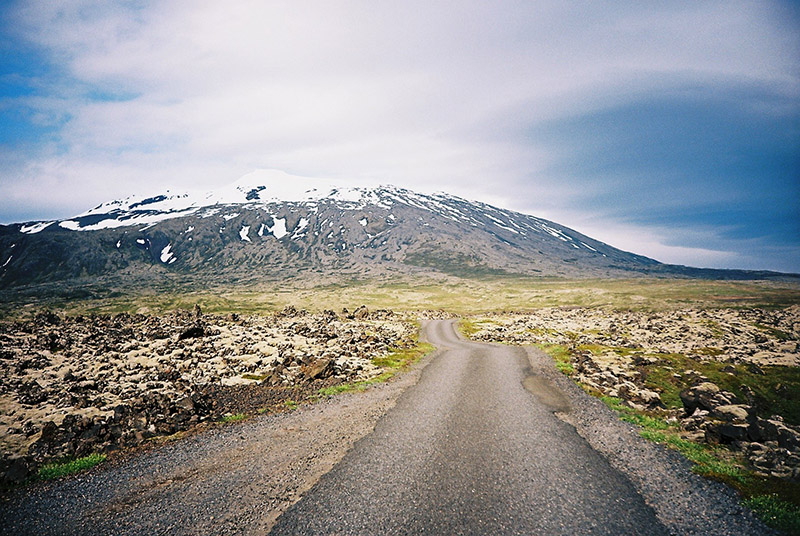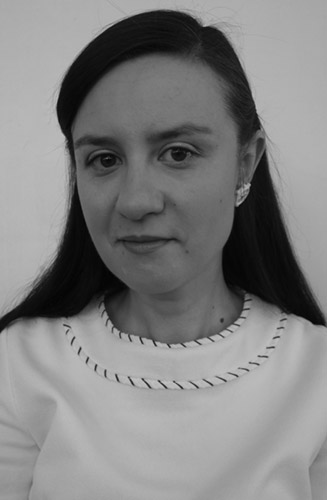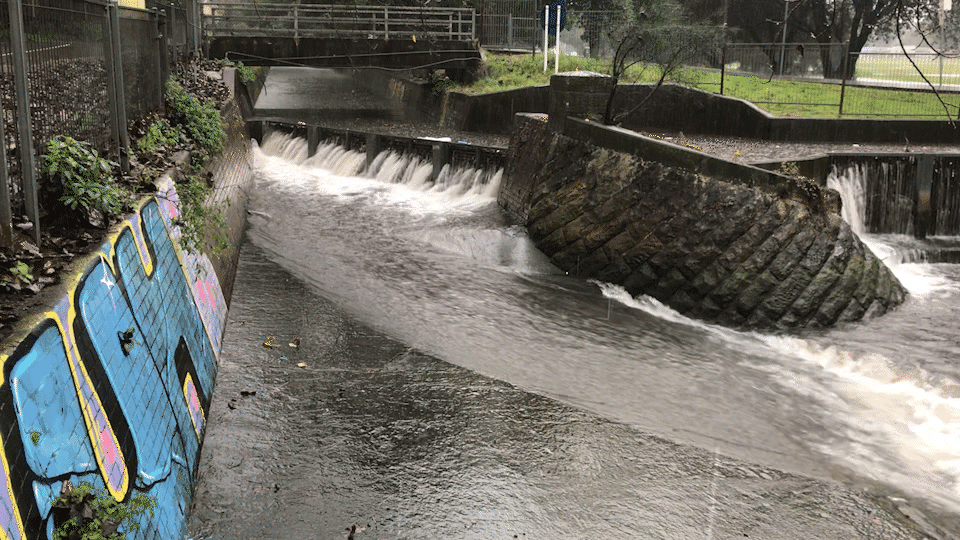On the door of Grái Kötturinn cafe is the painted face of a grey cat with green eyes. It grins awkwardly, its crooked white whiskers etched into the paint in thin lines like scratches. Although I had my eye out for the Grái Kötturinn, I almost missed it as I walked down Hverfisgata, the street which runs parallel to the harbour shoreline of Reykjavík. Seeing the painted grey cat, I open the red door and enter the cafe, a small room partitioned by bookshelves.
The books form a library for the regulars and tourists who make up the cafe’s visitors. Most of the books are in Icelandic, and I pick out one at random. It is a worn hardback with the words Ljósmyndir Sigfúsar Eymundssonar embossed in black script on the cover. Upon opening it, I see that it is an album of photographs of Reykjavík from the nineteenth century. I turn to an image of twenty men in front of a wooden bathing hut at the edge of a pool. Only their heads and shoulders are visible above the water in which they are submerged, lined up as if in a school photograph. Their cheeks are puffed out, faces grimacing against the cold air and with the exertion of treading water.
The photographs were taken by Sigfus Eymundsson, the first Icelander to successfully establish a photography studio. In 1867 he set up his photography business in Reykjavík, which was then only a small town of less than 2000 inhabitants. It is pictured in one of his photographs, a two-storey building with curtained windows, a woman in a shawl peering from the balcony above the sign on the awning: Eymundsson, Photographer. This was only one of the many enterprises Eymundsson pursued in his lifetime. He was a businessman and a merchant, a bookseller and publisher: the largest chain of bookstores in Iceland still bears his name.
As I look through the city panoramas and images of street life in Eymundsson’s photographs I visit a sparse, huddled city, paused in the midst of its daily rhythms of commerce and leisure. I stop at another image, of salted fish laid out to dry, the stretched shapes of the flattened codfish covering the stony ground like flaking skin. Further back are women in white aprons laying out the fish. They stand with carts and stretchers, some continuing irrespective of the camera’s presence, others looking up at it and thus meeting my gaze. As they watch me from the page I turn to the window and the street outside, overlaying the monochrome figures from the photographs onto the contemporary scene.
On the other side of Hverfisgata from the Grái Kötturinn is Culture House, a solid neoclassical building that houses medieval manuscripts among its collection of treasures. This building also has an animal guardian. Above the entrance is a stone shield with a bird of prey carved into it, claws thick and gnarled. The two creatures mark the city’s extremes: the cat’s realm is the cosy Reykjavík houses with windowsills decorated by cacti and figurines, while the domain of the eagle is the colossal Mount Esja, the mountain range across the harbour that fills the horizon.
On this clear day the slopes of Esja are sharply etched against the sky. In the mountain’s folds are seams of snow, trapped from the winter, in shapes like chalk scribbles. Esja is the city’s mountain, and Reykjavík residents observe its moods and changes like that of a companion spirit. The artist Louisa Matthíasdóttir’s mid-twentieth-century paintings of Reykjavík, which portray the city in bright colours and long shadows, often include the distinctive shape of Esja across the harbour. In speaking of her relationship to the mountain, she described their bond as inevitable. Just by seeing it every day, she said, ‘it was bound to take hold of me’.
Live in a place and it weaves into your identity, its atmospheres entwining with your own. To write of these atmospheres is to examine the texture of the weave and how self and place are braided together. In Sydney I have a lifelong relationship to the city and the suburbs that underlies my observations but in Reykjavík I am a visitor, here for only a week. My knowledge of this city remains on the surface, guided by the shape of the streets and my pathways through them, and the stories of this place that I encounter.
Beside Culture House is the Arnarhóll, a steep, grassy hill topped by a statue of Ingólfur Arnarson. The city’s foundation story is that, as Arnarson approached the coast of Iceland from Norway, he threw the carved wooden pillars from his ceremonial high seat overboard for good luck. As was Norse tradition, he would settle where they landed. Three years later, in the year 874, the pillars were found. They had washed ashore in a bay where the ground steamed from thermal springs, giving the place its name, Reykjavík (smoky bay). It was here Arnarson settled and where the city would take shape a thousand years later. To commemorate this story, one of the statue’s muscular arms grasps a spear, the other rests on a pillar in the shape of a dragon-head. It is a monument to a powerful man, but also to the forces of chance. As the pillars floated out from Arnarson’s ship, his future travelled with them, to be determined by the ocean currents and storms of the North Atlantic.
The grass of the Arnarhóll is spotted with dandelions, giving the hill a yellow glow. It’s only a short rise to the top, but steep enough to change the aspect. From here I can look out over the harbour, towards the omnipresent Esja and the Harpa concert hall in the foreground, jutting out like a crystal. Harpa is a hopeful building, symbolic of Iceland’s recovery after the collapse of the country’s economy in 2008. Less than half-constructed when the crash hit, Harpa remained a partial hulk until the government stepped in to fund its completion. Perched at the water’s edge, the building’s skin is a double layer of glass scales that shift in colour, iridescent.
Voices nearby shift my attention to three little girls who are lining up at the top of the hill, below Arnarson and the dragon pillar. They lie down in a row, like beads in a necklace, hold their arms to their sides and roll, giving themselves over to the hill and gravity. The one who rolls the furthest lets out a fierce cry of victory, which echoes across the park like a bird call.
Inside the concert hall I’m enclosed by a towering wall of glass scales. It is the last day of NonfictioNOW, the writing conference that has brought me to Reykjavík. Both of the final day’s presenters, Aisha Sabatini Sloan and Wayne Kostenbaum, speak of nonfiction that steps outside the frame. The frame is a flexible metaphor, meaningful in the sense of both paradigm and form. For Sloan, the frame is the non-fiction writing establishment which privileges white voices and produces forms and styles that uphold this privilege. For Kostenbaum, the frame is the neat and linear. His address is a series of stories that balance and tumble on the edge of non-fiction and fiction. ‘Plastic metaphoric things occur to me with tremendous voltage’, he says, describing their making.
Voice is formed by speaking and by listening, and stepping out of the frame honours both these actions. I take this idea with me from the conference as I travel out from Reykjavík. Stepping outside of the frame is something I practice in my own work, writing on urban and suburban Sydney. In doing so I pay close attention to details of the physical environment, examining traces and alternate narratives. This is a subtle form of stepping compared to that brought about by travel, where the act of physical dislocation actively shifts my perception of place.
Leaving Reykjavík I consider how a city is another kind of frame. Its streets, municipal buildings, cafes and parks form a civic structure that bridges my unfamiliarity with this country. Outside of the city I’m plunged into scenes where my voice is shaped by the material vitality of the landscape. The wavering purple lupins that grow thickly by the roadside; the popcorn topography of lava fields, lunar-stark. The places I encounter test my ability to listen, to perceive them on their own terms.
Driving north I have the radio tuned to a local station and the chatter of the announcers for company. At first I search the Icelandic syllables for recognisable words but then settle into the lilting sound of the language as it overlays the landscape. These are the words of this place, they move swiftly like the thin, white trails of water that plunge down through the cracks in the mountains, and the rivers that flow towards the black sand beaches and the ocean.

I turn off the Ring Road to travel west, following the perimeter of the Snaefellsnes peninsula, towards Snæfellsjökull, the mountain at the peninsula’s end. An enormous, dormant volcano, topped by a glacier, its white peak is cracked like a boiled egg dented by a spoon. Climb to its summit, then down into the crater until you are below the earth’s surface, and there are prehistoric forests, groves of forty-foot-high mushrooms, and an inland sea – at least according to Jules Verne. Journey to the Centre of the Earth, published in 1864, is a fantasy adventure novel inspired by travellers’ accounts of Iceland, its dramatic geography, and this brooding mountain.
Iceland is a literary landscape, crisscrossed by histories and fictions. The Sagas – the set of medieval texts that form the centrepiece of Icelandic literature – animate the map with the stories of the earliest generations of Icelanders. The allegiances and betrayals that shaped their lives form epic tales that read as both history, myth and parables of human nature. Saga tales are reworked and referenced throughout Icelandic literature and the works of writers from abroad who have been inspired by the country’s landscape and stories.
A love of the human drama of the Sagas inspired W.H. Auden, who in 1936 travelled to Iceland with Louis MacNeice, in order to write a travel guide. The resulting Letters from Iceland is eclectic, unorthodox. In the opening poem, Auden writes:
I want a form that's large enough to swim in, And talk on any subject that I choose.
The book is travel guide as collage, casting the reader into poetry and prose, letters in verse to Lord Byron, collections of quotes, and practical travel information: advice on gumboots and the hiring of ponies for expeditions.
Among this, Auden and MacNeice weave in details from the Sagas. In ‘Journey to Iceland’ Auden describes how the Saga stories are present in the landscape:
The site of a church where a bishop was put in a bag,
The bath of a great historian, the rock where
An outlaw dreaded the dark
Remember the doomed man thrown by his horse and
crying:
"Beautiful is the hillside, I will not go.":
The old woman confessing: "He that I loved the
Best, to him I was worst."
This confession is a line from the Laxdæla saga, the answer given by the heroine Guðrún to her son, when he asks which of her four husbands she had most favoured. Of all the moments in the Sagas this is one that has resounded through time. Succinct as a riddle, it opens into the emotional terrain of love, with its cruelties and contradictions.
On the Snaefellsnes peninsula the literary landscape is encountered in layers. Verne’s adventure tale is perhaps the most widely known, but Verne himself never visited Iceland. In the 1960s Halldór Laxness wrote back to Verne’s account of the mountain in Under the Glacier. Laxness, who won the Nobel prize for literature in 1955, has charted the connections between land, people and spirit.
Under the Glacier, like Verne’s novel, involves a journey. At the behest of the bishop of Iceland a young man travels to a village by Snæfellsjökull to investigate the parish and its priest. The novel is narrated through a series of conversations a young man, known only as Embi (for ‘emissary of the Bishop’), has with the priest and villagers. He finds Pastor Jón has turned to mysticism, ceasing to give sermons because: ‘it’s better to be silent. That is what the glacier does.’ In this part of the country it is well known that glacier is the centre of the universe, Pastor Jón explains. Embi discovers that the village is the kind of place where people and their livestock subsist on coffee and cakes; a dead woman turns into a fish (and then, after burial in glacial ice, come back to life); and a guru and his followers congregate to ‘attempt reanimation’ by harnessing the galactic connection obtained through Snæfellsjökull. This weird, wry novel weaves together the lore of the sagas with 1960s counterculture, critiques of religion, and philosophical meditations on the nature of time which, as Pastor Jón explains, ‘is the one thing we can all agree to call supernatural’.
Time does feel different here, geological and dynamic. Iceland is situated on the mid-Atlantic ridge, a spine of undersea mountains that have risen as a result of volcanic activity between the North American and European tectonic plates. The island’s surface seems thin, with stretches of flatlands ruptured by sudden mountains. The earth cracks apart into streams and rivers, plumes of steam vent from geothermal hotspots, lava-rocks form craggy sculptures, and, above it all, the sky is huge and ever-changing with clouds.
At the end of the peninsula, with the looming Snæfellsjökull behind me, I stop at a beach of black pebbles called Djúpalónssandur. Among the black stones are scraps of twisted, rusting metal, the remains of an English fishing boat that was wrecked here in 1948. I walk until everyone else on the beach is behind me: the girls holding up heart-shaped rocks to pose for photos, the family standing at the edge of the lagoon that was once thought to be so deep it was bottomless. As I sit on the smooth, black pebbles, looking out to sea, the waves curl in and recede over the stones in a slow rhythm. The waves keep time like a pendulum, continuing, but not counting.
On the northern side of the peninsula I drive along the flat, curving road that cuts through the Berserkjahraun lava fields. The lava stretches out to either side in an uneven pattern of pale green-grey lichen and sharp black rock. Produced by a series of volcanic eruptions four thousand years ago, in its arrested form the lava still has something of the curling, creeping energy that brought it into being.
The path through this lava field is written of in Eyrbyggja Saga, a key saga of the Snaefellsnes peninsula. Like many saga stories, it is a tale of love and death. Two men cleared the path in a day, promised if they could do so one of them would be given a local farmer’s daughter’s hand in marriage. The men were Berserkers, Viking warriors from Sweden said to fall into frenzied trances of violence during battle. The farmer hadn’t thought it possible that they would succeed, so when they did, he decided to kill them rather than surrender his daughter. The story has an eerie immediacy in this place. Besides the road and its sparse traffic, it must look much the same now as then.
Beyond the lava field is a stretch of flat grasslands. In the distance I see a hump of land rising up from the flat fields, Helgafall, or Holy Mountain. This is a place where sagas intersect. Guðrún of the Laxdæla Saga, whose confession was quoted by Auden, is said to be buried at its foot. The Eyrbyggja Saga describes this mountain as a threshold to the afterlife. The saga records that, when the son of Þórólfr Mostrarskegg, the first settler of the area, died at sea, a shepherd saw the mountain open up and the glow of fires inside it, and heard the sounds of a raucous party welcoming his spirit.
This story, and the mountain’s continuing history as a holy place in Christian times, has been transposed into a contemporary tradition. If you ascend without looking behind you and without speaking, then at the summit you may make three wishes. I follow the path up, refining my wishes in my thoughts, and at the top send them out towards the distant mountains, imagining them taking to the air, travelling, landing somewhere by chance.
I can see the town of Stykkishólmur, its buildings dotted along a strip of coastal land. I first heard about this place three years ago as I sat with the poet Kate Middleton in her house in Sydney. As we drank tea and talked about atlases and libraries she told me about the Library of Water. An installation by the American artist Roni Horn, it is located in a clifftop building in Stykkishólmur, and made up of a collection of water sourced from Iceland’s glaciers. Soon after I encountered The Library of Water again, as a place of respite and reflection for Rebecca Solnit in The Faraway Nearby. Reading of Solnit’s time here I imagined the Library like a pearl or a prism, a place of literary refuge, so far from the path of my life that I was certain it would not twist in such a way to lead me there.
I park the car outside the Stykkishólmur branch of the Directorate of Fisheries, a small warehouse constructed, like many houses and commercial buildings in Iceland, of corrugated iron. The yard that runs alongside it is decorated by a harpoon mounted on a metal plinth, its hook pointed towards the bay where the fishing boats are moored. I can see the Library of Water on the hill directly above, the curved facade of the building like an enormous eye, looking out to sea.
It looks simple enough to get to, but the roads take me on a roundabout route. I start along a street of corrugated iron houses with wide mansard roofs. Each is painted a different colour, peach, moss-green, grey. In the long yard of one of these houses a team of teenagers have been raking freshly mown grass into mounds. The scent of the grass carries on the wind, the hopeful, fresh smell of summer. The job is mostly done and the group stands together, leaning on their rakes. One boy lies flat on his back in the centre of the yard, his arms and legs stretched out in a star-shape, eyes closed to the sun.
At the end of the street is the Library of Water, perched at the edge of the bluff. This building was once filled with books, as it had been the town’s local library. When the library relocated to a larger premises in the mid-2000s, the building stood empty until it was repurposed as a venue for Horn’s installation.
There’s an insulated feeling inside the Library as if I, too, am contained within glass, like the columns of glacial water. These extend from floor to ceiling, clustered at the entrance to the room like a transparent forest. The water morphs the view of the houses and the harbour down below. I watch the streets, where I had walked only a few minutes earlier, stretch and distort through the columns.
In Journey to the Centre of the Earth and Under the Glacier I had read about Snæfellsjökull and its mythological power. That day I had driven around the mountain’s perimeter, and imagined time broadened out, increased in scale. Here, in the hilltop eye of the Library of Water, Snæfellsjökull is something rarefied, preserved. I touch my hand to the column in which its water is sealed, and as I lean in towards it, I watch the world outside refracted through its solemn transparency.
Vanessa Berry attended the NonfictioNow conference with the support of an ArtsNSW Artist Support grant and the Copyright Agency Ignite Career Fund.


